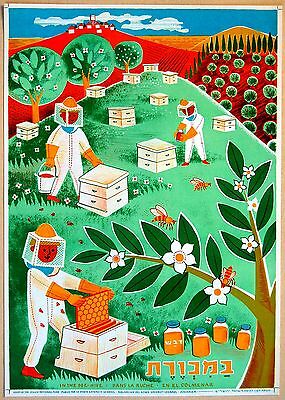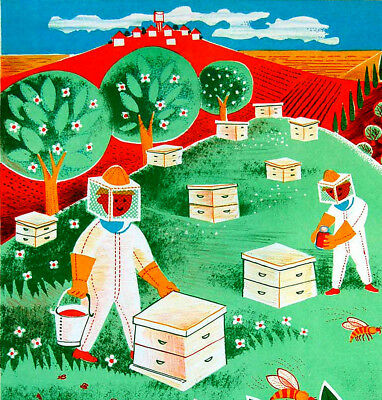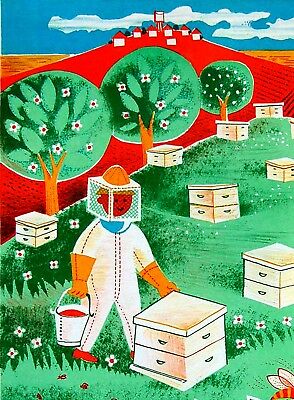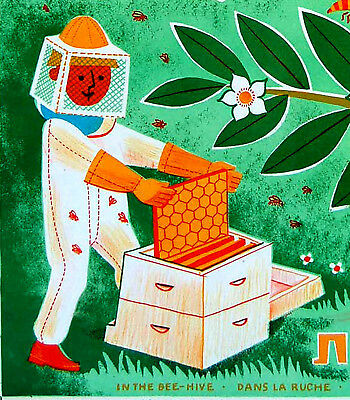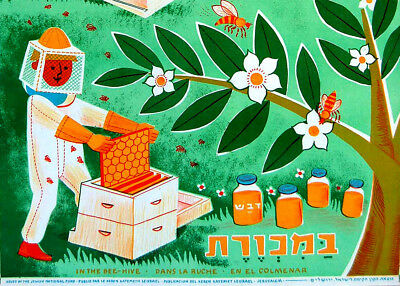-40%
1962 Israel JEWISH POSTER Apiculture BEE HIVE Judaica KKL Honey HONEYCOMB Hebrew
$ 25.87
- Description
- Size Guide
Description
DESCRIPTION:
Up for sale is a genuine authentic vintage around 50 years old LITHOGRAPHIC ZIONIST JEWISH POSTER illustrated in VIVD COLORS , Which was issued by the JNF ( Jewish National Fund ) - KKL ( Keren Kayemet Le'Israel ) in
the very early 1960's , Propably 1962
. The LITHOGRAPHIC Judaica poster depicts a typical israeli BEE HIVE in a KIBBUTZ or a SETTLEMENT and an IMAGE of Israeli farmers among the BEE HIVES and the HONEY BEES , Collecting HONEY and HONEYCOMBS , All in the scenery of KIBBUTZ and ORCHARDS . The Hebrew TITLE is " IN THE BEE HIVE " . Written also in English, French and Spanish. A colorful LITHOGRAPHIC Printing . The poster SIZE is around 13" x 19" . Printed on thin stock. Very good condition.
No folds, Tears, Creases or stains whatsoever
( Please look at scan for actual AS IS images )
Poster will be sent rolled in a special protective rigid sealed tube.
AUTHENTICITY
:
The poster - broadside comes from a KKL- JNF old wharehouse and is fully guaranteed ORIGINAL from the very early 1960's , It is NOT a reproduction or a recently made reprint or an immitation , It holds a life long GUARANTEE for its AUTHENTICITY and ORIGINALITY.
PAYMENTS
:
P
ayment method accepted : Paypal.
SHIPPING
:
Shipp worldwide via registered airmail is $ 25 . Poster will be sent in a special protective rigid sealed tube .
Handling around 5 days after payment.
The Jewish National Fund (Hebrew:
קרן קימת לישראל
,
Keren Kayemet LeYisrael
) (abbreviated as JNF, and sometimes KKL) was founded in 1901 to buy and develop land in Ottoman Palestine (later British Mandate for Palestine, and subsequently Israel and the Palestinian territories) for Jewish settlement. The JNF is a quasi-governmental, non-profit organization. By 2007, it owned 13% of the total land in Israel.Since its inception, the JNF has planted over 240 million trees in Israel. It has also built 180 dams and reservoirs, developed 250,000 acres (1,000 km) of land and established more than 1,000 parks. ***
Honey is a sweet food made by bees using nectar from flowers. The variety produced by honey bees (the genus Apis) is the one most commonly referred to, as it is the type of honey collected by beekeepers and consumed by humans. Honey produced by other bees and insects has distinctly different properties. Honey bees transform nectar into honey by a process of regurgitation and evaporation. They store it as a primary food source in wax honeycombs inside the beehive. Honey gets its sweetness from the monosaccharides fructose and glucose, and has approximately the same relative sweetness as that of granulated sugar. It has attractive chemical properties for baking and a distinctive flavor that leads some people to prefer it over sugar and other sweeteners. Most microorganisms do not grow in honey because of its low water activity of 0.6. However, honey sometimes contains dormant endospores of the bacterium Clostridium botulinum, which can be dangerous to infants, as the endospores can transform into toxin-producing bacteria in infants' immature intestinal tracts, leading to illness and even death. Honey has a long history of human consumption, and is used in various foods and beverages as a sweetener and flavoring. It also has a role in religion and symbolism. Flavors of honey vary based on the nectar source, and various types and grades of honey are available. It is also used in various medicinal traditions to treat ailments. The study of pollens and spores in raw honey (melissopalynology) can determine floral sources of honey.Bees carry an electrostatic charge whereby they attract other particles in addition to pollen, which become incorporated into their honey; the honey can be analysed by the techniques of melissopalynology in area environmental studies of radioactive particles, dust and particulate pollution. Bees are flying insects closely related to wasps and ants, and are known for their role in pollination and for producing honey and beeswax. Bees are a monophyletic lineage within the superfamily Apoidea, presently classified by the unranked taxon name Anthophila. There are nearly 20,000 known species of bees in seven to nine recognized families, though many are undescribed and the actual number is probably higher. They are found on every continent except Antarctica, in every habitat on the planet that contains insect-pollinated flowering plants. Bees are adapted for feeding on nectar and pollen, the former primarily as an energy source and the latter primarily for protein and other nutrients. Most pollen is used as food for larvae. Bees have a long proboscis (a complex "tongue") that enables them to obtain the nectar from flowers. They have antennae almost universally made up of 13 segments in males and 12 in females, as is typical for the superfamily. Bees all have two pairs of wings, the hind pair being the smaller of the two; in a very few species, one sex or caste has relatively short wings that make flight difficult or impossible, but none are wingless. The smallest bee is Trigona minima, a stingless bee whose workers are about 2.1 mm (5/64") long. The largest bee in the world is Megachile pluto, a leafcutter bee whose females can attain a length of 39 mm (1.5"). Members of the family Halictidae, or sweat bees, are the most common type of bee in the Northern Hemisphere, though they are small and often mistaken for wasps or flies. The best-known bee species is the European honey bee, which, as its name suggests, produces honey, as do a few other types of bee. Human management of this species is known as beekeeping or apiculture. Bees are the favorite meal of Merops apiaster, the bee-eater bird. Other common predators are kingbirds, mockingbirds, beewolve, and dragonflies EBAY322f
